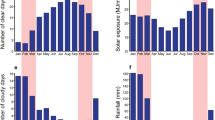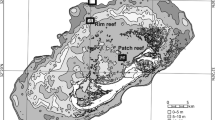Abstract
The recent intensification of human disturbances in the Caribbean has increased the prevalence of partial mortality on coral colonies. Partial mortality can change colony size by directly shrinking colonies or by splitting colonies into fragments. A reduction in colony size can also adversely affect fecundity and fitness as internal resources shift away from reproduction toward colony maintenance. This study aimed to determine whether three Caribbean coral species, Siderastrea siderea, Montastraea faveolata, and Diploria strigosa, along the reef tract in Puerto Morelos, Mexico (20o52′N, 86o51′W), continued to dedicate resources to reproduction when colonies were fragmented to pre-maturation size. Contrary to expectations, eggs were found in colonies that were smaller than the maturation size and had been subjected to partial mortality. The continued dedication of resources toward reproduction, even in the smallest colonies, suggests that resource trade-offs away from reproduction are not as rigid as previously suggested in stressed corals.



Similar content being viewed by others
References
Babcock RC (1988) Age-structure, survivorship and fecundity in populations of massive corals. Proc 6th Int Coral Reef Symp 2:625–633
Banks JE (1997) Do imperfect trade-offs affect the extinction debt phenomenon? Ecology 78(5):1597–1601
Fine M, Oren U, Loya Y (2002) Bleaching effect on regeneration and resource translocation in the coral Oculina patagonica. Mar Ecol Prog Ser 234:119–125
Harrison PL, Wallace CC (1990) Reproduction, dispersal and recruitment of scleractinian corals. Ecosyst World 25:133–207
Hughes TP, Connell JH (1987) Population dynamics based on size or age? A reef coral analysis. Am Nat 129(6):818–829
Hughes TP, Jackson JBC (1980) Do corals lie about their age? Some demographic consequences of partial mortality, fission, and fusion. Science 209:713–715
Hughes TP, Baird AH, Bellwood DR, Card M, Connolly SR, Folke C, Grosberg R, Hoegh-Guldberg O, Jackson JBC, Kleypas J, Lough JM, Marshall P, Nystrom M, Palumbi SR, Pandolfi JM, Rosen B, Roughgarden J (2003) Climate change, human impacts, and the resilience of coral reefs. Science 301(5635):929–933
Jackson JBC (1986) Modes of dispersal of clonal benthic invertebrates: consequences for species’ distributions and genetic structure of local populations. Bull Mar Sci 39(2):588–606
Kai S, Sakai K (2008) Effect of colony size and age on resource allocation between growth and reproduction in the corals Goniastrea aspera and Favites chinensis. Mar Ecol Prog Ser 354:133–139
Kojis BL, Quinn NJ (1985) Puberty in Goniastrea favulus age or size limited? Proc 5th Int Coral Reef Congr 4:289–293
Leuzinger S, Willis BL, Anthony KRN (2011) Energy allocation in a reef coral under varying resource availability. Mar Biol 159:177–186
Maynard S (1978) The evolution of sex. Cambridge University Press, Cambridge
Okubo N, Motokawa T, Omori M (2007) When fragmented coral spawn? Effect of size and timing on survivorship and fecundity of fragmentation in Acropora formosa. Mar Biol 151:353–363
Rinkevich B (1996) Do reproduction and regeneration in damaged corals compete for energy allocation? Mar Ecol Prog Ser 143:297–302
Rinkevich B, Loya Y (1985) Intraspecific competition in a reef coral: effects on growth and reproduction. Oecologia 66:100–105
Sakai K (1998) Gametogenesis, spawning and planula brooding by the reef coral Goniastrea aspera (Scleractinia) in Okinawa, Japan. Mar Ecol Prog Ser 151:67–72
Selman C, Blout JD, Nussey DH, Speakman JR (2012) Oxidative damage, ageing, and life-history evolution: where now? Trends Ecol Evol 27(10):570–577
Silvertown J (2008) The evolutionary maintenance of sexual reproduction: evidence from the ecological distribution of asexual reproduction in clonal plants. Int J Plant Sci 169(1):157–168
Soong K (1993) Colony size as a species character in massive reef corals. Coral Reefs 12:77–83
Soong K, Lang JC (1992) Reproductive integration in reef corals. Biol Bull 183:418–431
Stearns SC (1989) The evolutionary significance of phenotypic plasticity. Bioscience 39:436–444
Szmant AM, Gassman NJ (1990) The effects of prolonged “bleaching” on the tissue biomass and reproduction of the reef coral Montastraea annularis. Coral Reefs 8:217–224
Szmant-Froelich A (1985) The effect of colony size on the reproductive ability of the Caribbean coral Montastraea annularis (Ellis and Solander). Proc 5th Int Coral Reef Congr 4:295–300
Tomascik T, Sander F (1987) Effects of eutrophication on reef-building corals. Mar Biol 94:77–94
Van Veghal MLJ, Kahmann MEH (1994) Reproductive characteristics of the polymorphic Caribbean reef building coral Montastraea annularis. II. Fecundity and colony structure. Mar Ecol Prog Ser 109:221–227
van Woesik R (2010) Calm before the spawn: global coral-spawning synchronization is explained by regional wind fields. Proc R Soc B 277:715–722
van Woesik R, Jordan-Garza AG (2011) Coral populations in a rapidly changing environment. J Exp Mar Biol Ecol 408:11–20
Villinski JT (2003) Depth-independent reproductive characteristics for the Caribbean reef-building coral Montastraea faveolata. Mar Biol 142:1043–1053
Ward S (1995) The effect of damage on the growth, reproduction and storage of lipids in the scleractinian coral Pocillopora damicornis (Linnaeus). J Exp Mar Biol Ecol 187:193–206
Wyers SC (1985) Sexual reproduction of the coral Diploria strigosa (Scleractinia, Faviidae) in Bermuda: research in progress. Proc 5th Int Coral Reef Congr 4:301–306
Acknowledgments
We extend our thanks to Roberto Iglesias-Prieto, Anastazia Banaszak, and Robin Smith for extensive support throughout the field- sampling process. We also thank Sandra van Woesik for editorial comments. Universidad Nacional Autonoma de Mexico (UNAM), Instituto de Ciencias del Mar y Limnologia is gratefully acknowledged for logistic support, including the use of laboratory space, boats, and equipment. This research was supported by a grant from the World Bank and Global Environmental Facility (GEF) through the Coral Reef Targeted Research (CRTR) and Capacity Building for Management program and was partially supported by the Hoover Foundation.
Author information
Authors and Affiliations
Corresponding author
Additional information
Communicated by R. Hill.
Rights and permissions
About this article
Cite this article
Graham, J.E., van Woesik, R. The effects of partial mortality on the fecundity of three common Caribbean corals. Mar Biol 160, 2561–2565 (2013). https://doi.org/10.1007/s00227-013-2248-y
Received:
Accepted:
Published:
Issue Date:
DOI: https://doi.org/10.1007/s00227-013-2248-y




